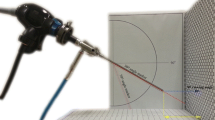Abstract
Purpose
Arthroscopic images are subject to distortion, which may increase when using arthroscope lenses with greater reflecting angles and/or viewing structures at oblique angles. The purpose of this study was to determine the magnitude of image distortion experienced when using arthroscopes with different lens angles and when the line-of-sight (i.e., viewing angle) is not directly perpendicular to the target.
Methods
A dot calibration target was captured through 0°, 30°, and 70° arthroscopes from straight (i.e., directly perpendicular) and 30° oblique viewing angles. Distortions in horizontal and vertical distances in deep (located at 87.5 % length of arthroscopic image diameter) or shallow (12.5 % diameter length) regions were calculated, from which a deformity ratio (horizontal/vertical distance) was determined.
Results
From the straight viewing angle (0°), both horizontal and vertical distances were artificially reduced (i.e., <100 % magnification) in the shallow and deep regions. The deformity ratio was ~100 % in the central region, declining to ~80 % peripherally. From the oblique viewing angle (30°), magnification was below 100 % in the deep area but exceeded 100 % in the shallow area, with increasing distortion associated with increasing lens angle (0° < 30° < 70°). For all lens angles, the deformity ratio was ~50 % in the deep area but neared 100 % in the shallow region.
Conclusions
Arthroscopic image distortion in peripheral regions should be considered when using angled-lens arthroscopes, especially when the viewing angle is not straight. As viewing the femoral ACL footprint through the anterolateral portal involves using an oblique viewing angle, visualization through the anteromedial portal is recommended.








Similar content being viewed by others
References
Aglietti P, Buzzi R, Giron F, Simeone AJV, Zaccherotti G (1997) Arthroscopic-assisted anterior cruciate ligament reconstruction with the central third patellar tendon. A 5-8-year follow-up. Knee Surg Sports Traumatol Arthrosc 5:138–144
Ahmed M, Farag A (2005) Nonmetric calibration of camera lens distortion: differential methods and robust estimation. IEEE Trans Image Process 14(8):1215–1230
Asari KV, Kumar S, Radhakrishnan D (1999) Technique of distortion correction in endoscopic images using a polynomial expansion. Med Biol Eng Comput 37:8–12
Bedi A, Altchek DW (2009) The “footprint” anterior cruciate ligament technique an anatomic approach to anterior cruciate ligament reconstruction. Arthroscopy 25(10):1128–1138
Colombet P, Robinson J, Christel P, Franceschi JP, Djian P, Bellier G, Sbihi A (2006) Morphology of anterior cruciate ligament attachments for anatomic reconstruction: a cadaveric dissection and radiographic study. Arthroscopy 22(9):984–992
Davis MH, Khotanzad A, Flamig DP, Harms SE (1997) A physics-based coordinate transformation for 3-D image matching. IEEE Trans Med Imaging 16(3):317–328
Ferretti M, Ekdahl M, Shen W, Fu FH (2007) Osseous landmarks of the femoral attachment of the anterior cruciate ligament: an anatomic study. Arthroscopy 23(11):1218–1225
Helferty JP, Zhang C, McLennen G, Higgins WE (2001) Videoendoscopic distortion correction and its application to virtual guidance of endoscopy. IEEE Trans Med Imaging 20(7):605–617
Hoshino Y, Nagamune K, Yagi M, Araki D, Nishimoto K, Kubo S, Minoru D, Kurosaka M, Kuroda R (2009) The effect of intra-operative knee flexion angle on determination of graft location in the anatomic double-bundle anterior cruciate ligament reconstruction. Knee Surg Sports Traumatol Arthrosc 17:1052–1060
Hutchinson MR, Ash SA (2003) Resident’s ridge: assessing the cortical thickness of the lateral wall and rood of the intercondylar notch. Arthroscopy 19(9):931–935
Kallemeyn NA, Grosland NM, Magnotta VA, Martin JA, Pedersen DR (2007) Arthroscopic lens distortion correction applied to dynamic cartilage loading. Iowa Ortho J 27:52–57
Khalfayan EE, Sharkey PF, Alexander AH, Bruckner JD, Bynum EB (1996) The relationship between tunnel placement and clinical results after anterior cruciate ligament reconstruction. Am J Sports Med 24:335–341
Purnell ML, Larson AI, Clancy W (2008) Anterior cruciate ligament insertions on the tibia and femur and their relationships to critical landmarks using high-resolution volume-rendering computed tomography. Am J Sports Med 36:2083–2090
Shahidi R, Bax MR, Maurer CR Jr, Johnson JA, Wilkinson EP, Wang B, West JB, Citardi MJ, Manwaring KH, Khadem R (2002) Implementation, calibration and accuracy testing of an image-enhanced endoscopy system. IEEE Trans Med Imaging 21(12):1524–1535
Siebolt R, Ellert T, Metz S, Metz J (2008) Femoral insertions of the anteromedial and posterolateral bundles of the anterior cruciate ligament: morphometry and arthroscopic orientation models for double-bundle bone tunnel placement—a cadaver study. Arthroscopy 24(5):585–592
Sommer C, Friederich NF, Muller W (2000) Improperly placed anterior cruciate ligament grafts: correlation between radiological parameters and clinical results. Knee Surg Sports Traumatol Arthrosc 8:207–213
Van Eck CF, Lesniak BP, Schreiber VM, Fu FH (2010) Anatomic single- and double-bundle anterior cruciate ligament reconstruction flowchart. Arthroscopy 26(2):258–268
Yasuda K, Kondo E, Ichiyama H, Kitamura N, Tanabe Y, Tohyama H, Minami A (2004) Anatomic reconstruction of the anteromedial and posterolateral bundles of the anterior cruciate ligament using hamstring tendon grafts. Arthroscopy 20(10):1015–1025
Acknowledgments
The authors would like to acknowledge Smith & Nephew for using the arthroscopy system and their endoscopic research and development laboratory.
Conflict of interest
The authors declare that they have no conflict of interest.
Author information
Authors and Affiliations
Corresponding author
Rights and permissions
About this article
Cite this article
Hoshino, Y., Rothrauff, B.B., Hensler, D. et al. Arthroscopic image distortion—part I: the effect of lens and viewing angles in a 2-dimensional in vitro model. Knee Surg Sports Traumatol Arthrosc 24, 2065–2071 (2016). https://doi.org/10.1007/s00167-014-3336-3
Received:
Accepted:
Published:
Issue Date:
DOI: https://doi.org/10.1007/s00167-014-3336-3




